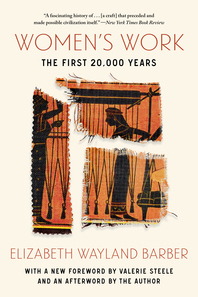
Women's Work
The First 20,000 Years
23 August 2024
Territory Rights — Worldwide.
Description
The 30th-anniversary edition of a historical account, called “brilliantly original” by Katha Pollitt (The Washington Post Book World), that reframed our understanding of women’s lives in early societies
Twenty thousand years ago, women were making and wearing clothing created from spun fibres. In Women’s Work, archaeologist-linguist Elizabeth Wayland Barber “weaves the strands of mythology and literature, ethnology and documented history into a rich tapestry” (John Noble Wilford, The New York Times Book Review), illuminating the vital role women held in preindustrial societies. With a distinctive and innovative approach to ancient remains, Barber examines ancient textiles from Stone Age string skirts and ancient Egyptian sleeved tunics to intricate Neolithic Swiss linens and colourfully patterned Minoan dresses, offering us captivating glimpses into the daily lives of women through the cloth they made and wore.
Reviews
"Elizabeth Barber is as knowing and perceptive as any archaeologist-author in sight… Her topic is wonderfully fresh." — Scientific American
"A fascinating history and prehistory of the making of textiles, a craft, exclusive to women (including queens and goddesses), that preceded and made possible civilization itself." — The New York Times Book Review
"Fortunately, this most distinctive of female occupations has a sympathetic and authoritative chronicler in Elizabeth Wayland Barber." — Mary R. Lefkowitz, The New York Review of Books
Also By: Elizabeth Wayland Barber 

Elizabeth Wayland Barber
Hardback, 2013
A fascinating exploration of an ancient system of beliefs and its links to the evolution of dance.

Elizabeth Wayland Barber
E Book, 2013
A fascinating exploration of an ancient system of beliefs and its links to the evolution of dance.

Elizabeth Wayland Barber
Paperback, 2000
In the museums of Ürümchi, the windswept regional capital of the Uyghur Autonomous Region (also known as Chinese Turkestan), a collection of ancient mummies lies at the center of an enormous...







